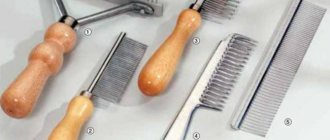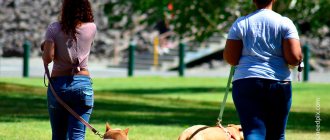Hitting a dog or forcing it to obey is now considered an outdated form of discipline. Today it has gone out of fashion, and in some countries it is even punishable by law. Education through pain has been replaced by more acceptable and, most importantly, effective methods. However, hitting the nose, muzzle or butt is still practiced and causes controversy among dog owners.
Does it mean he loves? Don't think!
How to punish a pet correctly
In essence, it is not punishment that is applied to dogs, but measures aimed at stopping inappropriate behavior. If the owner has already tried all possible measures of influence, and the pet still does not obey, then physical force can be used to:
- punishment for misconduct;
- behavior correction;
- suppression of dominant behavior.
If in order for a dog to hear its owner, you need to hit it, then you need to do it correctly. Unacceptable
hit the dog on:
- sides;
- head;
- stomach;
- breasts;
- ribs
The safest for your pet's health are moderate blows to the soft tissues along the body, that is, on the outer surface of the thigh. To do this, you should not use your hands or a leash, heavy or traumatic objects. The owner can acquire a special “whip” made from a broken flexible but strong stick without thorns, or buy it. The blow of such a “whip” is quite noticeable, but is safe for the pet’s health.
In general, you can punish a pet without using physical force. For example:
- Scold in a stern voice and ignore the dog for a while.
- Going out for a walk is only for the toilet; there should be no games with relatives or the owner. The dog must walk on a short leash, next to the owner.
- If an undesirable action occurs during a walk, the animal is put on a leash and all commands are quickly repeated, after which the owner and the pet go home.
When punishing, it is important to follow the following rules:
- Any impact, be it praise or punishment, must be timely. That is, as soon as the dog performed an action, the owner’s reaction should immediately follow. The pet will not understand the connection between the action and the deed if at least a few minutes have passed since its moment.
- When influencing a dog, the owner must strictly control his own emotions. You should not raise your voice at your pet if you are angry - this can provoke aggression and destroy trust, rather than achieve obedience.
- You cannot beat a dog for any offense; punishment in most cases should be psychological; this is the only way to maintain normal relations between the owner and the dog.
- The strength and duration of the punishment must correspond to the severity of the dog’s action.
- The pet must strictly follow prohibiting commands, then most unpleasant situations and unwanted behavior of the pet will be avoided.
- When a dog is punished by one of the family members, the rest should not interfere, try to feel sorry for or protect the pet. If this rule is not followed, then the pet will not learn the lesson given to it.
Each owner has his own approach to raising a pet, so everyone determines the possibility of using physical force independently. However, if a dog shows aggression towards family members and the owner himself, you should not limit yourself to strict suggestion - it is quite acceptable to hit the dog to show him his place in the hierarchy of the “pack”.
Deferred punishment
Usually people do not hit dogs constantly, but under the influence of strong emotions. This happens when the owner sees the consequences of the pet’s “entertainment”. Spanking is useless in this case. Animals are not able to connect their own actions in the distant past with punishment in the present.
Let's give an example. Imagine coming home and all your clothes are disheveled and scattered on the floor. Of course this will make you angry. At best, you will be reprimanded.
What is the dog thinking about at this moment?
The pet makes a non-obvious conclusion: the owner always returns angry, you need to stay away from him.
As a result, the companion experiences fear before you come home. Tension builds up. The shaggy friend misbehaves even more to relax. Some owners, realizing this, try to punish their pet immediately after committing a crime. This doesn't work either.
After beating, the dog begins to feel fear. She is quiet, but does not feel safe. Because of this, the pet becomes stressed. At any moment it can develop into aggression - a desperate attempt to protect oneself. As a result, the companion sometimes obeys, but becomes unpredictable. You are completely ruining your relationship with your dog. Instead of a devoted friend, you get a downtrodden creature who can suddenly snap.
Another natural question arises. How to show your pet that you are unhappy with his actions?
The harshest acceptable methods are light spanking and jerking with a leash. The second, contrary to stereotypes, is considered less preferable. A sharp jerk can injure a dog’s tender neck, but a slap on the butt will do nothing.
This does not mean that jerking and spanking are the only possible punishments. It is highly recommended to do without them. If you are forced to resort to extreme measures, you have made a mistake somewhere in your upbringing.
Humane punishment is a stern tone or look, a prohibiting command. Dogs understand emotions very well. You can lightly pat the puppy at the withers. Just don’t repeat this with tiny babies: until 2-3 months of age, companions should not be punished at all.
The dog will obey with pleasure if 2 conditions are met.
Learn to intrigue your pet and speak his language. Does the animal pick up food from the floor? Provide a distraction and reward training session.
It will be more profitable for your pet to pay attention to you, and not to the fish bone on the floor
Beating is an inhumane and senseless punishment. Raising your pet requires good relationships and positive reinforcement. If the animal understands your emotions and listens to you, you will achieve much more.
Source
The choice is up to the owner
There is a wide variety of ways to punish a dog. There are times when a pet’s life will depend on obedience to its owner.
For example, it is important to teach your dog to react correctly to cars. In addition, the habit of picking up anything from the ground can result in fatal poisoning
The effective way is noise
Even just a sharp clap will distract the attention of a curious puppy. The noise coming from a bunch of keys suddenly dropped nearby will be even more intense.
The element of surprise and negative impact will be clearly associated in the dog's mind with its action. And soon she herself will not want to go near even the most fragrant trash cans. For this method to work, the dog must not be allowed to understand that the owner is the source of the action. This will negate the entire effect. Therefore, you need to throw the keys in such a way that it is unnoticeable to the pet.
To hit or not to hit?
You can really hit or even beat a dog only in one case: at the moment when the animal really threatens the health or even the life of the owner or family members. When a dog’s aggression is directed at its owner, the dog must be defeated, and all means
. Otherwise, you will have to part with the dog, since the first attack will certainly be followed by a second, and the dog will begin to dictate its terms. This situation is, in principle, impossible for a well-bred pet, but exceptions do occur.
Of course, I don’t deal with cases when you have to defend yourself from a dog. If a huge Rottweiler is rushing towards you, then nothing but a stick will save you. And at least a stick would have saved me.
I mean, and the article will talk specifically about whether it is possible to beat a dog as punishment or behavior correction.
I argue that it is possible and necessary to beat a dog, but only in the most extreme cases, when other arguments do not help. Let me explain with an example.
It's no secret that dogs, especially large ones, always try to take a dominant position in the house. They inherited this when there is a constant struggle for primacy in the pack.
So, if you missed the moment when you could limit yourself to a word or even a glance (dogs understand glances perfectly!), you have to win a leading position. Not only for you, by the way, but also for other family members.
I know of a case where, right in our high-rise building, a huge male South Russian Shepherd dog went on a formal hunt for the owner’s seven-year-old son. I had to beat him (a male, of course!) like Sidorov’s goat so that he would understand who’s boss in the house.
However, in the end this did not help, and the dog had to be given away. You see how events can unfold if you don’t catch yourself in time.
I personally had a case. I adopted an 8 month old female Rottweiler from a kennel. And the nursery was at the “Red Star” military unit near Dmitrov in the Moscow region, if anyone knows.
So, I explained to her who’s boss for about two weeks. In emergencies, she had to use a mop, otherwise she didn’t understand.
But this concerns behavioral adjustments. What about punishment? Useless and even harmful. In most cases, the dog “commits illegal acts” when the owner does not see it.
So what happens? You come home, the dog is happy and rushes to you. Do you see scraps of books and magazines on the floor and start hitting her? The dog will never understand why. You're raising a coward, that's all.
Definitely, beating is NOT a punishment for a dog. You just vent your anger, but he/she still won’t understand why she or he is being hurt.
And all this talk, they say, can be done with a newspaper, but lightly. Who will you hit with a newspaper? The puppy who made a puddle? It's their own fault, they should have taken him out on time for a walk.
When you got a puppy, did you know that puppies make puddles? So teach him order, just don’t beat him. This will cause some dogs to make puddles out of spite. I've seen these.
Conclusion - it is better to do without beating, except in extreme, extreme situations when the dog really needs to be beaten so that it understands everything. And so, in ordinary life, don’t hit dogs.
There are plenty of other ways to train dogs other than hitting. Much more effective. And the heart will not break, because it’s a pity to beat, after all!
The first and basic rule of raising a dog. If you hit a puppy on a soft spot, it will do little good (not to mention the fact that it is inhumane). The dog will not understand such actions of yours, because animals in a pack do not hit each other.
Individual cases of “offenses”
After analyzing the prohibited techniques, you can move on to recommendations that explain how to punish a dog for disobedience without harming its health. The algorithm of actions depends on the specific “offense”, but usually 1 of 5 basic techniques is used.
Punishing a dog for aggression or biting
Aggression towards owners is often associated with attempts to dominate. It must be stopped with a stern reprimand and a strong press to the floor.
Puppy bites are a consequence of play aggression. If your child starts to bite you when he’s playing, say “Ugh” and stop playing immediately.
If passers-by are the target of the attack, scold the dog, pull the leash and be sure to purchase a muzzle. If there are repeated attempts to attack, sign up for OKD courses at the kennel club.
How to properly punish a dog or puppy for disobedience
Punishment methods do not depend on age. These include:
Abstraction. Splashes of water from a spray bottle, the sound of a whistle, clapping and pulling the leash are good distractions from unwanted actions.
Ignoring. Recommended for begging
Ignore your pet's sad eyes until he gives up.
Rebuke. Spoken in a stern and calm voice
When calling, it is better to use “bad dog” or “bad dog” instead of a nickname.
Deprivation. Temporarily removing any toy demonstrates your superiority. Give it back for following a command or other positive action.
Light shaking by the scruff of the neck and pressing to the floor. The position of submission is extremely humiliating, so the quadruped will try everything possible to avoid it in the future.
Note that destructive behavior is often associated with excess energy. If your pet simply doesn’t have enough activity, increase the duration and quality of walks by adding variety in the form of outdoor games.
Punishing a dog for improper urination
If diseases of the urinary system are excluded, then you need to give a reprimand immediately after leaving a puddle. If the dog is just about to relieve himself and is rushing around in search of a convenient place, distract him with a strict “Ugh” and take him outside as soon as possible.
Punishment for unacceptable behavior: at home and on the street
The methods of punishing dogs at home and on the street are practically the same. The only caveat is the presence of ammunition for the walk. With the help of light tugs on the leash, the animal can be discouraged not only from attacking others, but also from picking it up from the ground.
Some educational moments
Of course, the owner must balance the severity of the punishment, and often during the training process, a hit or jerk with the leash will discipline the animal. Raising a dog as it grows or practicing certain elements of obedience sometimes simply requires forceful techniques. When and how to use force?
- The age of puberty is dangerous for owners of male dogs, since at this time the formation of the “masculine” qualities of the pet occurs, he can show aggression towards others and the owner, disobey, snap back, and strive to establish his own laws in the family. A young animal (especially large breeds) begins to feel its strength. At the first manifestation of such symptoms of puberty, the owner is simply obliged to defend his leadership, and often force becomes the only argument. There is no need to beat the pet when it tries to bite the owner, this does not work. You have to defeat him in the literal sense: throw him to the ground and hold him until he resigns himself and stops struggling. The expression of submission on the face is a signal that the dog has recognized its submission.
- A slap on the face with a rag or newspaper is an effective way to show the dog his place in the family. Intrusive behavior and the desire to steal a tasty morsel from the table are stopped with a light blow and a sharp shout. A voice command must be given before physical impact.
- A dog's nose is a delicate, sensitive place. sharp blow to the nose with a leash is always very painful, so it can only be used in exceptional cases. For example, it helps to instantly pacify an aggressive large dog that does not respond to shouts and jerks.
The owner must prove his leadership.
When to and when not to punish a dog or puppy
First, remember that your reaction to your pet’s actions should be immediate. Delayed reinforcements don't work.
It is recommended to punish the pet for the following offenses:
- Stealing food. Stop stealing from people's tables at an early stage and under no circumstances encourage begging.
- Sleeping on your bed without permission. If you like to sleep together, then this is absolutely normal and even creates a special trusting relationship. The problem is that putting yourself in someone else's place is an attempt at dominance that can undermine your authority.
- Aggression towards people and other animals. This behavior is unacceptable, especially towards the owners. It is necessary to prohibit not only a real attack, but also a threatening growl with attempts to bite.
- Damage to things. “Gnaws” are soothing and fun, but in the future, because of them, you can lose all your shoes and new repairs. Avoid touching your belongings, but be sure to offer alternatives such as chew toys or bones.
- Relieving yourself at home. If you plan to train your pet to use a litter box, then the ban should be partial. Punishment is only necessary when the dog pees past the tray.
- Any disobedience. Lack of response to commands is an equally compelling reason. Having remembered that they give a treat for doing it, and a severe reprimand for ignoring it, the pet will most likely prefer the first option.
If the moment has already been missed, then there is no point in punishing the four-legged animal. Being told off for chewing your shoes after a couple of hours will at best cause confusion, and at worst make you a villain. A pet happily wagging its tail, having received a dose of negativity upon meeting its owner, will prefer to simply hide under the sofa next time.
There is no need to scold your pet even if he has stopped behaving badly. With negative reinforcement, the positive outcome is the cessation of punishment. If the dog has done everything correctly, but is still being reprimanded, then he simply will not respond to your prohibitions in the future. Indeed, in this case, the correct reaction does not bring any benefits.
Another important point to remember is systematicity. Never cut corners. Undesirable actions should always be punished, and good behavior should always be rewarded.
Basic Techniques
"Come to me" command. Ideally, your dog should run towards you on command. It is much easier to control a pet who is fluent in this command. As a rule, few people have problems during the learning process. Conduct regular training
In addition, you need to pay attention not only to the fact of why the pet does not want to stay in the yard, but also to train it not to do so. Regular exercise will tire the dog and it will not want to waste energy. Sterilization
Neutered dogs are less likely to travel and are also not attracted to members of the opposite sex. On the other hand, you have the need to monitor interactions with other dogs. Install a fence. Give your pet enough space to move around without worry. If you decide to install a fence, you need to make it high enough so that the dog cannot jump over it. You also need to cement the foundation so that it does not undermine. If you do not want to resort to such a measure, then periodically check to see if your four-legged friend has gone on a journey. Always work on your pet's behavior. Your responsibility during a walk is to explain to him in an understandable way what he can do and what he cannot do. If you have not done this, keep the animal on a leash. Also, include your number and home address on the collar. If you're lucky, if you lose it, caring people will return your pet. After it has been returned to you, do not scold it, but rather praise it and give it something tasty. If you encourage him to return, then sooner or later he will understand that this place is his home. Enjoy spending time together with your pet. For many, dogs are good friends who take owners on various adventures. In addition, arrange your yard so that the animal is not interested in leaving its confines. Train his behavior, encourage obedience with delicious food. Also buy him toys so that he can chew and fiddle with them. Add variety to your dog's life. Very often they become bored with backyards, so they may run away to explore a new area. Take your pet for rides in the car, if possible, and take them to parks and training grounds.
You need to create conditions that will ensure that the pet does not go on wanderings.
Why do people beat dogs and does it bring the desired results?
There are four reasons why people hit dogs:
- A man who beats a dog gets emotional release
. He came home after a hard day at work, and even received a reprimand from his superiors, and at home - another puddle or chewed shoes. I beat the dog and it seemed to make me feel better. The problem is that such a scenario is a reinforcement for the person, which means he will hit the dog over and over again. Will this teach the dog how to behave? Very doubtful. But it will teach you to fear the owner and not trust him. - A person tries to stop the dog's unwanted behavior by hitting him
.
For example, a dog tried to steal a piece of sausage from the table - a person hit it, the dog dropped the sausage and ran away. The dog barks - the man beat it, it fell silent. Has the effect been achieved? It seems that yes, the behavior has stopped. But in reality, no. The fact is that beating has no effect on the dog's motivation
, and its need remains unsatisfied.
This means that the dog will look for other ways - and it’s not a fact that you will like them more. Perhaps the dog will no longer steal from the table in the presence of the owner - but what will stop him from doing this when his back is turned or is in another room? If a dog barks from overexcitement, hitting it will not make it calmer, which means it will either bark again and again, or the overexcitement will result in other behavior problems. In addition, by beating a person does not teach the dog alternative behavior
, that the need can be satisfied in an acceptable way. - The owner does not know that it is possible to interact with the dog differently.
To be honest, in our age of information capabilities, this is perceived as a mocking “excuse”, nothing more. Here is the time to remember the saying: “Those who want, look for opportunities; those who don’t want, look for reasons.” And there are more than enough opportunities now. - The owner just likes to hit the dog
. Alas, this is not so rare - an attempt to convince oneself of one’s own importance and omnipotence by harming another living being, or to satisfy sadistic inclinations. But there is nothing to comment here. The only acceptable way to deal with this is normal, working laws aimed at protecting animals, identifying such individuals and banning the keeping of dogs. In the post-Soviet space at the moment, this is, unfortunately, a utopia.
Finally, hitting dogs is downright dangerous. According to the results of the study, at least 25% of dogs immediately respond to their owner's aggression with aggression. Other dogs initially show signals of submission that most owners simply do not notice, which means that the dog has no choice but to defend itself, and as a result we get a dog that is dangerous to the owner and others. In some dogs, such methods create learned helplessness, which sometimes suits the owners, but in this case the dog constantly experiences distress, which affects its health and level of well-being.
Photo: pixabay
What is the best age to train a dog?
Raising a puppy, like an adult dog, begins from the moment the animal reaches its owner. Basic commands should begin to be practiced immediately upon bringing the pet into the house: the owner must show where the pet has a place, where it eats and where it can relieve its natural needs.
You should not get angry at your furry family member and hit him if he does not immediately learn the basics of behavior, especially for small puppies.
Irrational punishment can completely kill a dog’s trust in a person; therefore, further training will not be as effective. Remember, the owner and his family members should always be in authority for the pet.
A dog can only be punished at the same moment the unfavorable act is committed.
If this happens later, then the animal will not form a logical chain about what was done and the owner’s reaction. On the contrary, the dog will associate the owner’s aggression with him, which can destroy his trust and cause aggression.
Is it possible to hit a dog as punishment? This question worries many dog owners. There is no clear opinion here - some believe that education is impossible without physical punishment, others are sure that the use of physical force is unacceptable. In fact, every owner must find a middle ground. For example, if a puppy couldn’t wait to go outside and made a puddle in the house, you shouldn’t hit him, it’s better to give him a suggestion in a serious voice.
If the dog showed aggression - growled, attacked or bit the owner, a member of his family, then it is necessary to immediately show who is the “leader”. To do this, you can hit the dog noticeably, but not too hard (kicks or heavy objects are unacceptable - this can injure the animal), and then throw the dog on its back and, holding it in such a “subordinate” position, growl. The pet should be kept in this position until it stops resisting and unconditionally accepts the authority of the “leader”. But you can’t use this technique every day - it can break the dog’s psyche.
This is interesting: Dog training, agility, education and skills: we describe it point by point
Consequences of an aggressive attitude towards an animal
What happens if you hit a dog? The dog will lose trust in its owner. The person to whom he entrusted his life suddenly causes him pain, and it is usually accompanied by abuse. The dog cannot understand what happened because he only understands a clear cause-and-effect relationship. For example, if he stole a piece of sausage from the table, the owner immediately scolded him, then the dog knew why. If it suddenly happened that the dog did something wrong in the morning, and the owner hit him many hours later, the dog will be completely bewildered, not understanding or remembering why. The point here is the animal’s lack of logical thinking; a dog is capable of thinking only with its “reason.”
The dog may become embittered, and this is already a danger. A small dog can be dealt with, but a big one is not far from trouble. The dog's response to aggression is quite understandable. In such situations, the “dog-human” relationship simply reaches a dead end, and they sometimes have to part ways.
On a note. Experienced dog handlers never hit a dog with their hands. Their measures of influence are strict collars, special batons and other means. However, they know the extent of the pain, calculate the force, and see the reaction. At home, a non-professional will not be able to cope with such tasks.
The dog may become very frightened, which will further lead to a breakdown of its nervous system and, as a consequence, to concomitant diseases. An owner in anger can cause unbearable pain to his friend. The dog will remember her for a long time, and at the slightest offense he will begin to fear a new attack from the owner. However, this will not lead to obedience and strict execution of commands, but will make the animal uncontrollable.
On a note. A dog is an individual with its own position in life. One of its postulates is peace, when it is disturbed, the life of the pet and the owner is also disturbed.
From these truisms it becomes clear why you should not hit a dog. How does a person react to such conflicts? Of course, aggression also affects his psyche; he becomes angry and irritable. He sometimes has feelings of guilt and pity, which are aggravated by new aggression.
For example, the answer to the question why pregnant women should not beat animals is explained not only by superstitious approaches (the birth of a defective child)
It is also taken into account that aggression that occurs between a pregnant woman and a dog can negatively affect the health of the baby and mother. And the point here is not only in the psychological aspect, the dog can simply attack and severely bite the expectant mother
Constructive dog training methods
In cynology, there are several ways to train dogs, all of them are humane and effective:
- The mechanical method involves some kind of impact, for example, to practice the “Sit” command, the owner presses the dog’s croup with his palm. Over time, this turns into a conditioned reflex. A jerk on the leash works in a similar way. The advantage of this type of training is the strong reinforcement of behavior.
- Food method. For following a command, the dog receives a treat. Taste stimulation is easy to use at home and on a walk; this method arouses great interest in the animal, strengthens the contact between the trainer and the ward, and evokes only positive emotions.
- The imitation method is used as an educational aid, most often for puppies. Well suited for practicing Voice commands.
The best results come from a combination of all training methods. If you stop controlling your pet, he begins to growl, show his dominance, you need to give a strict rebuff. It is allowed to hit the dog on the nose; a slight click will be unpleasant and painful, but will not entail serious consequences. For small breeds, turning the animal on its back or side is suitable.
Third way
The latter method is considered the most effective and is recommended by experienced dog handlers. Raising a dog takes place without outsiders. The owner independently teaches the dog to carry out commands, relying on theoretical knowledge, his own experience (if any) and advice from specialists.
You cannot punish a dog if it does not immediately follow commands, because the intelligence of all animals is different. However, for a correctly executed command, the reward should follow immediately. In addition, the pet must be praised.
Is it possible to hit a dog for training purposes?
But cynology has taken a more humane path in its development. Instructions about beatings gave way to recommendations about spanking with a newspaper, and then the minds of dog lovers were conquered by motivational and rewarding training methods. Today it is already believed that you should not hit your dog with a leash, hand, or other objects.
But some still believe that physical dominance can bring good results. That pets, as bright representatives of pack animals, are subject only to physical superiority. Following this twisted logic, the owner must hit his dog because there is no other way to force him to obey commands.
However, such methods can achieve obedience, not love, of the animal. Education is certainly necessary, but not through violence, inflicted injuries and crippled psyche of your pet. Practical observations of trained methods of physical dominance of an animal are almost universally prone to attacks of aggression or panic.
Praising is safer than hitting
A more effective motivation and reward program is one that instills in dogs the necessary reflexes during the learning process. It is aimed at praising the pet, not punishing it.
Photo: https://www.dogdeliver.com/blog/wp-content/uploads/2019/02/felicità-1200×720.jpg
You can't hit an animal! An angry owner is not able to calculate the force of blows delivered to the bridge of the nose, muzzle, ears and other sensitive places. He inflicts severe pain on the animal and intimidates his ward with cruel treatment rather than teaching good behavior and obedience.
Measures for dealing with difficult dogs
But such decisions are made by experienced trainers taking into account all possible risks, especially the manifestation of a fearful reaction. And strictly calculate the force of physical impact so that injury does not occur.
Are beatings and other physical measures acceptable when training difficult dogs? If kicks and punches are meant to be permissible, the answer is undoubtedly no. Under no circumstances should there be beating in anger - never! Although physical strength has its place in certain types. For example, in teaching defense or hunter skills.
Dog packing
It was already mentioned above about packing, about the social position and status in this pack, where the older and stronger dominate over the younger and weaker, which is supposedly the norm in the nature of predators. But the key point here is sociality. This means the right of the canine individual to his own point of view.
Photo: https://vripmaster.com/uploads/posts/images/5/55/Teach-Your-Dog-to-Play-Dead-on-Command-Step-4.jpg
Dogs, like people, have the right to a peaceful existence. By beating, the owner robs the animal of its peace, replacing it with being in constant fear. That is, simply put, physical dominance disrupts and destroys the naturally fulfilling life of a pet.
Is it possible to avoid conflicts?
In real life, there are dogs that literally test their owners and seem to deliberately drive them to extremes. Often this looks like teenage rebellion, especially when the pet is a born leader and will strive to establish its own dominance in the house. Then the owner will have to withstand a serious test of strength and character.
Most owners, making excuses because the animal is young, make concessions and give up slack. But some people understand that things will get even worse if the wayward pet is not stopped in a timely manner. Before serious tests, the dog will begin to probe the weaknesses of the owner
It is important not to miss such a moment and not to allow a conflict of characters to develop.
If you immediately stop your pet's actions at the very beginning, he is unlikely to reach a state of teenage rebellion. Then you won’t need to muster all your will into a fist in the fight against the tailed bully to show who is in charge.
Possible options for gently nipping conflicts of interest in the bud:
- During walks, the pet runs in front of its owner, taking the leading role for itself. Can be stopped by the command “Near!”
- Demonstrates superiority, does not respond to calls, runs away during a walk. Prevented by leashes and ultrasonic collars, additional training of calling.
- Shows a grin and growls at the first stage of dominance. The best reaction is to ignore and command “Place!”
- Goes to bed on upholstered furniture. He is stopped strictly with a harsh tone and sent to the lounger.
Why You Should Never Hit Your Dog
A dog that is being physically punished will naturally become evasive and fearful. And that's not what we want in a pet, right? And a dog that is afraid of its owner will never be able to properly take an order or fully understand what the owner wants it to do.
And remember that dogs are extremely sensitive creatures and are very capable of perceiving our emotions. Expressing anger through physical violence or deciding to hit a dog will only result in:
- The dog will run away when you want to punish it.
- Alternatively, he will confront the situation and try to attack.
- Your dog will express his frustration and anxiety through a number of distressing behaviors: breaking objects, compulsively licking certain areas of his body, urinating in inappropriate places, etc.
If this happens, the solution is obviously not to increase the level of physical punishment, but to find other ways to teach your dog how you want him to behave. If you do this, problems will gradually begin to resolve. If they still persist, you should seek professional help, but be sure to consult with a knowledgeable and responsible expert.
shutterstock
Strike while the iron is hot
When deciding how to punish a dog for disobedience, we must not forget that animals do not have logical thinking similar to that of a person. The dog will not understand that he is being punished for a shoe chewed several hours ago or a puddle made 10 minutes ago, even if you take him to the scene of the crime and poke his nose at this very crime for a long time (which cannot be done in principle). An angry half-hour lecture will not clarify the situation for the animal either.
In dogs, only the cause-and-effect relationship works perfectly. I did it and got the result. Fulfilled the command - got a tasty treat - good! He started gnawing on the table leg - he heard a shout - it’s bad. Played with the owner's shoe - slept - played with his toy - the owner came - received punishment - bad. And what is bad? The owner came - it’s bad. This is what untimely training will look like for a dog.
Peculiarities of canine perception
The character of an animal is formed not only at birth, but also in the process of upbringing
For this reason, the importance of training and socialization should not be underestimated.
The first month after the arrival of a four-legged family member in the house is the hardest. It is during this period that the owner needs to gain authority, suppress dominance on the part of the animal and define the boundaries of what is permitted.
Studying canine perception will help you avoid basic mistakes. Despite the lack of logical thinking, four-legged pets perfectly understand cause-and-effect relationships. That is why both positive and negative reinforcement are used when raising them.
How does an animal react to prohibition and punishment?
Negative reinforcement must accompany any unwanted behavior. Thanks to prohibitions and punishments, the dog understands the boundaries of what is permitted and tries to prevent the repetition of an unpleasant situation for it. This principle is used to teach the commands “Fu” and “No”.
Contrary to popular belief, negative reinforcement does not create retaliatory aggression and cowardice. Both occur when using prohibited techniques.
How does an animal react to praise?
Positive reinforcement is perceived by the four-legged pet with great enthusiasm, so praise and other methods of encouragement are used more often. The most important thing is not to miss the moment.
Due to poorly developed long-term memory, dogs only remember recently completed actions. They should be praised immediately after completing the command. Approval too early or too late will simply confuse them.
Praise helps animals distinguish bad actions from good ones. After the owner’s enthusiastic words, they are glad that they did the right thing: they squint with pleasure, wag their tail and breathe more intensely. For the sake of another reward, your pet will enthusiastically repeat any actions that you approve.
Reasons for bad behavior
Most of the reasons for bad behavior in pets are due to improper training. This includes a poor psycho-emotional climate (tense situation in the house), disregard for the authority of the owner and permissiveness.
Is it okay to hit your dog for training purposes?
Just a few decades ago, it was believed that hitting a dog for training purposes was acceptable. The training methods were based on physical dominance over the animal. Dog handlers believed that according to this principle, a leader is chosen in a pack, the dog is a pack animal, and his obedience can only be achieved in this way.
Subsequently, humanity and the study of psychology provided new methods of training. Systematic violence has been shown to produce uncontrollable reactions. Fear appears, the instinct of self-preservation is activated, the pet begins to defend itself and show aggression. Training based on motivation and encouragement gives better results and is safe for pets.
Water treatments
Water is the most irritating factor that dogs try not to come into contact with. Thanks to water procedures, you can quickly and painlessly cool down your pet’s ardor and teach him obedience. The liquid should be cool, not hot. Don't pour a whole bucket on your dog. One large mug is enough.
How to punish a dog with water? Dog handlers recommend using a spray bottle. Started growling? Did you grab a soft toy? you need to spray the pet several times so that it stops its actions and learns that it is not necessary to do this. Training a dog is a long and painstaking job. There are many methods for raising pets.
This creates confusion
If you get home and see a puddle or pile, your first instinct may be to scold your dog for it. The problem with this approach is that your dog will not associate the punishment with the crime. Sure, your dog will show you his repertoire of peace signals when you yell at him - hunching over, hiding his tail, lowering his eyes - but this is just his reaction to your anger in the moment. This is not “shame” or an admission of guilt, your dog’s behavior is actually an attempt to calm you down.
When it comes to teaching, time is of the essence, and scolding your dog hours after the misdeed is the worst option. The best way to “reprimand” a minor mistake is to catch your dog at the moment of committing an inappropriate action and interrupt it with a sharp “Hey!” Then take (or take) her outside so she can finish her business, without any comments, stern praise after successful completion.
Scold the culprit
Scolding a dog for misbehavior is the simplest and safest method. How to punish a dog if it craps in the house or behaves inappropriately? You need to learn how to scold her correctly. It is not recommended to raise your voice in hopes of achieving positive results. It often happens that in such cases the pet begins to growl at its owner and may even bite. You need to control yourself and learn to work in stages: call the dog (by name), make an angry expression on your face and scold, but without raising your tone.
If a dog snaps when you punish it, it means that it does not recognize the authority of its owner. The reasons for this behavior can be very different, but the main one is that at some point mistakes were made in upbringing. As a result, the dog began to consider its position as such that everything was allowed to it. You cannot yell at her or hit her in such situations. All family members should engage in re-education. It is necessary to stop showing the dog your great love for it (hug it, kiss it, treat it with something tasty). You need to calmly but persistently seek from her the execution of all reasonable and necessary commands (“Come to me!”, “Place!” and so on).
It's unfair to hit dogs
The main reason why a dog should not be hit is that it is unfair. Dogs are loyal companions, and unlike people, they do not have a vindictive nature. When dogs upset owners, it's likely not because he or she is naughty or unruly; rather, dogs simply act the way nature intended them to. They will not stop behaving this way simply because they do not understand our standards and rules.
Thus, the owner must provide direction and leadership, which can be effectively achieved in a non-confrontational manner through positive training. This type of training mainly focuses on praising good behavior and ignoring bad behavior. Owners who fail to train their dogs with effective training methods and resort to dog hitting should be aware of the negative impact this punishment has on the dog and on the overall owner-dog relationship.
The following are a few reasons why a dog should not be affected.
It causes behavior changes
In addition to potentially causing defensive aggression, hitting dogs can leave them vulnerable. They may become tight and there may be occasional urination, all of which can cause the dog to have low self-esteem. They may no longer walk with their heads held high, but rather walk with their tail between their legs and their heads held low. They may become particularly anxious, nervous, overly submissive, and live in fear.
It hurts the connection
Dogs that get hurt will not trust their owners. Owners should be the primary source of trust and guidance. Instead, abused dogs may cower at the idea of being pets and may become frightened by sudden movements. They will not be able to reach their full potential because too much energy will be spent living in fear of their owners.
The four-legged enemy of man. Protection from a fighting dog
So, a few words about miracle techniques. But first, about the miracle special forces. Not a single dog owner will allow his dog to practice some technique to the end and even to the point of pain, because the dog’s psyche, after a person hurts it in battle, breaks down , and after that it is afraid to attack people, accordingly it does not will perform its protective functions. Therefore, the maximum you can do is imitate and imitate something on a dog. Techniques to the end, for example, taking pain control or striking, and even at half strength it is unlikely that it will be possible to work on it only with a very light touch.
Deadly points
Next, about the lethal points:
Adam's apple - tearing out a dog's Adam's apple. It’s quite difficult to pull out a dog’s Adam’s apple, I say because the dog’s Adam’s apple is protected:
The dog will not wait for you to do something with its Adam's apple. Most likely, when you try to hit the Adam's apple, it will move to the side and shift.
The moment you try to pull it out, the dog will bite you, i.e. I do not consider this technique to be a technique with a high degree of reliability.
Blow to the spine
A good idea is to hit the dog on the side of the ribs, especially in the area of the lower, so-called floating ribs, the ends of which are not attached to the sternum. When fractured, there is a chance that the sharp appendages of these ribs will stick into the dog's internal organs, thereby causing internal bleeding and painful shock.
is a good idea .











